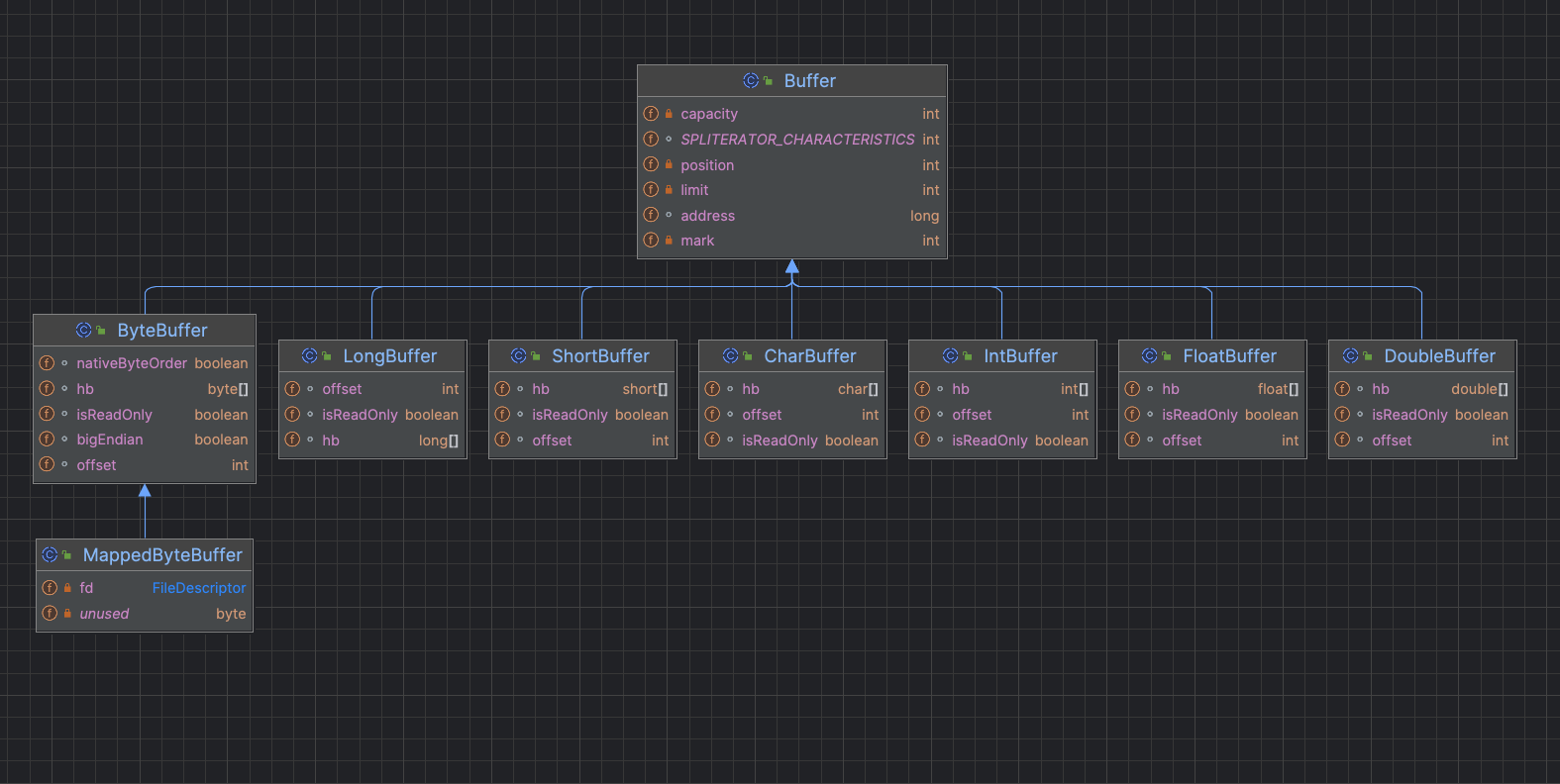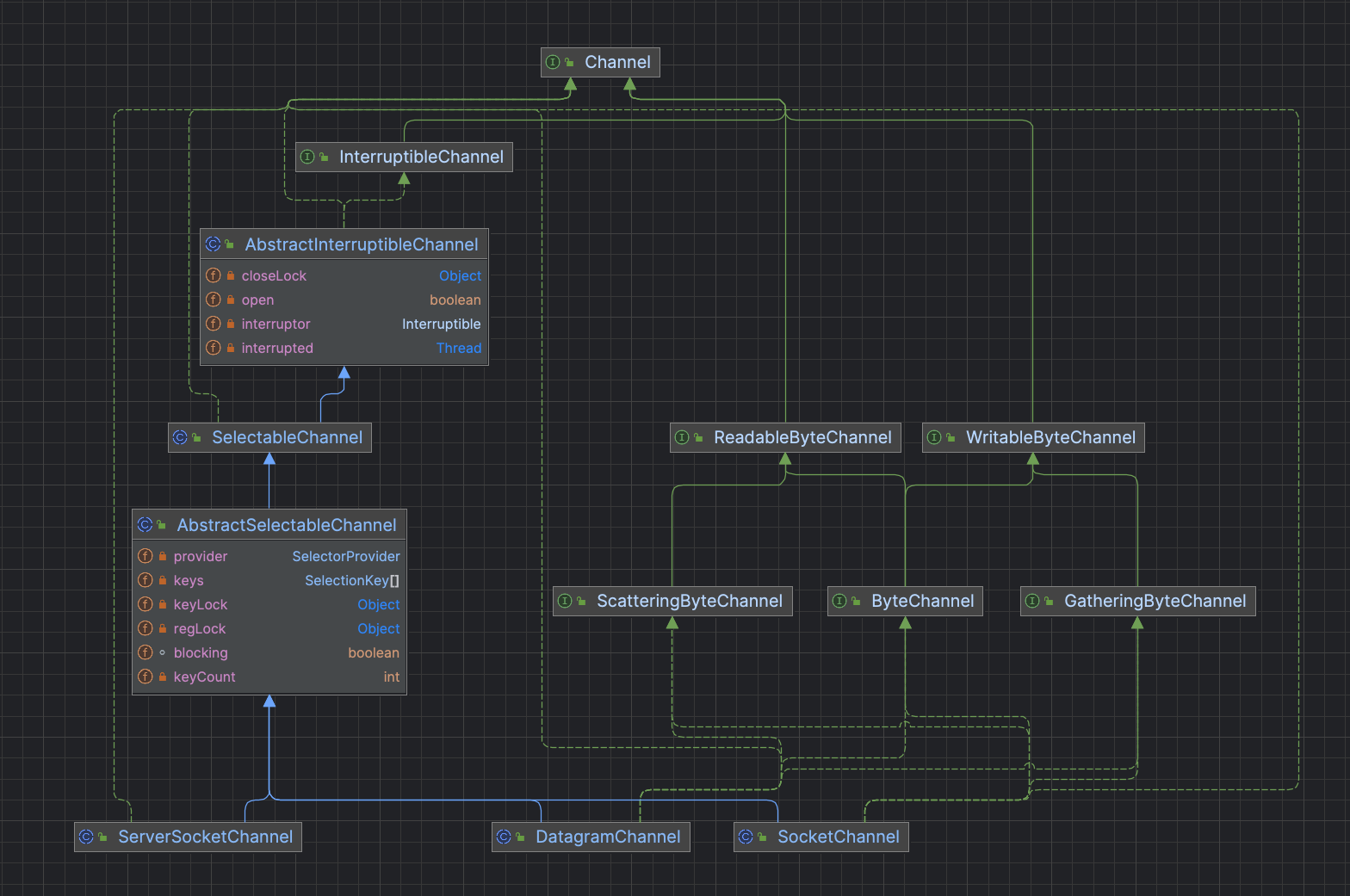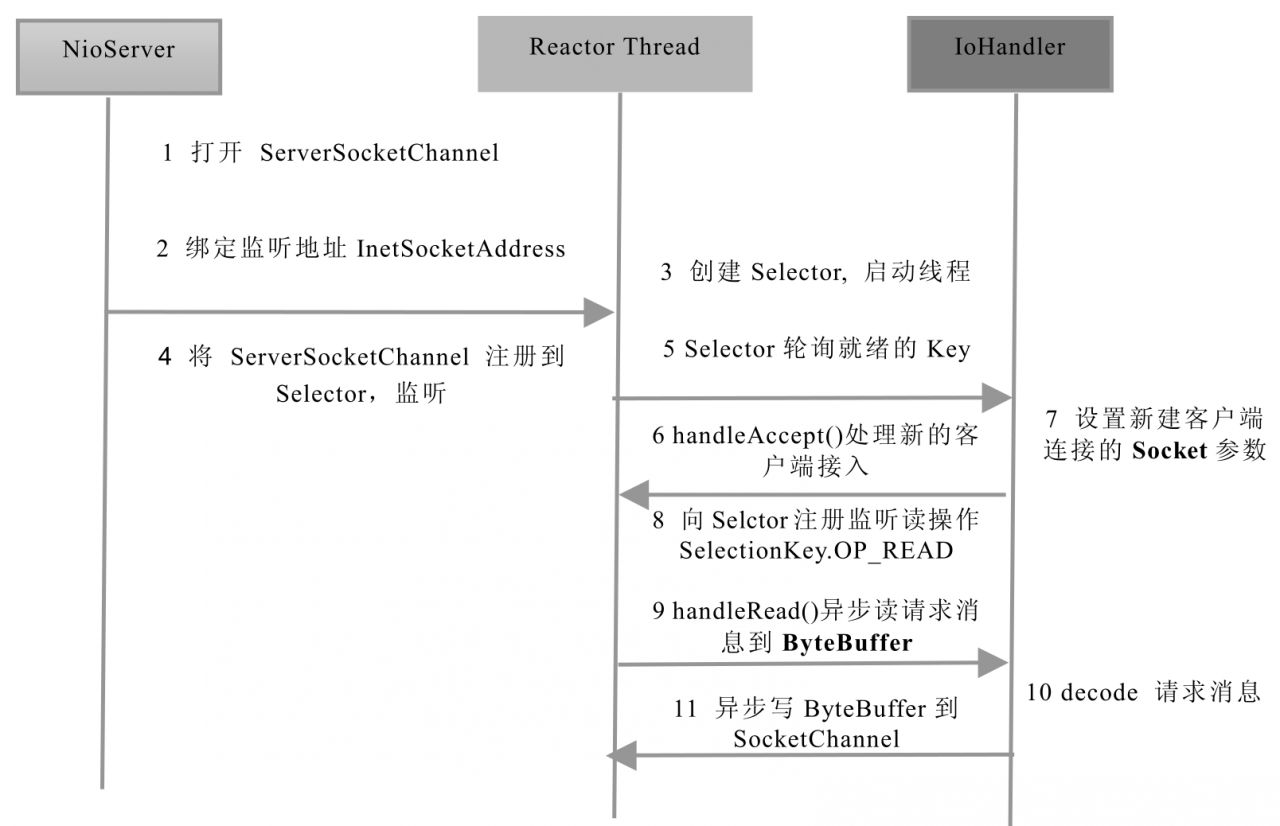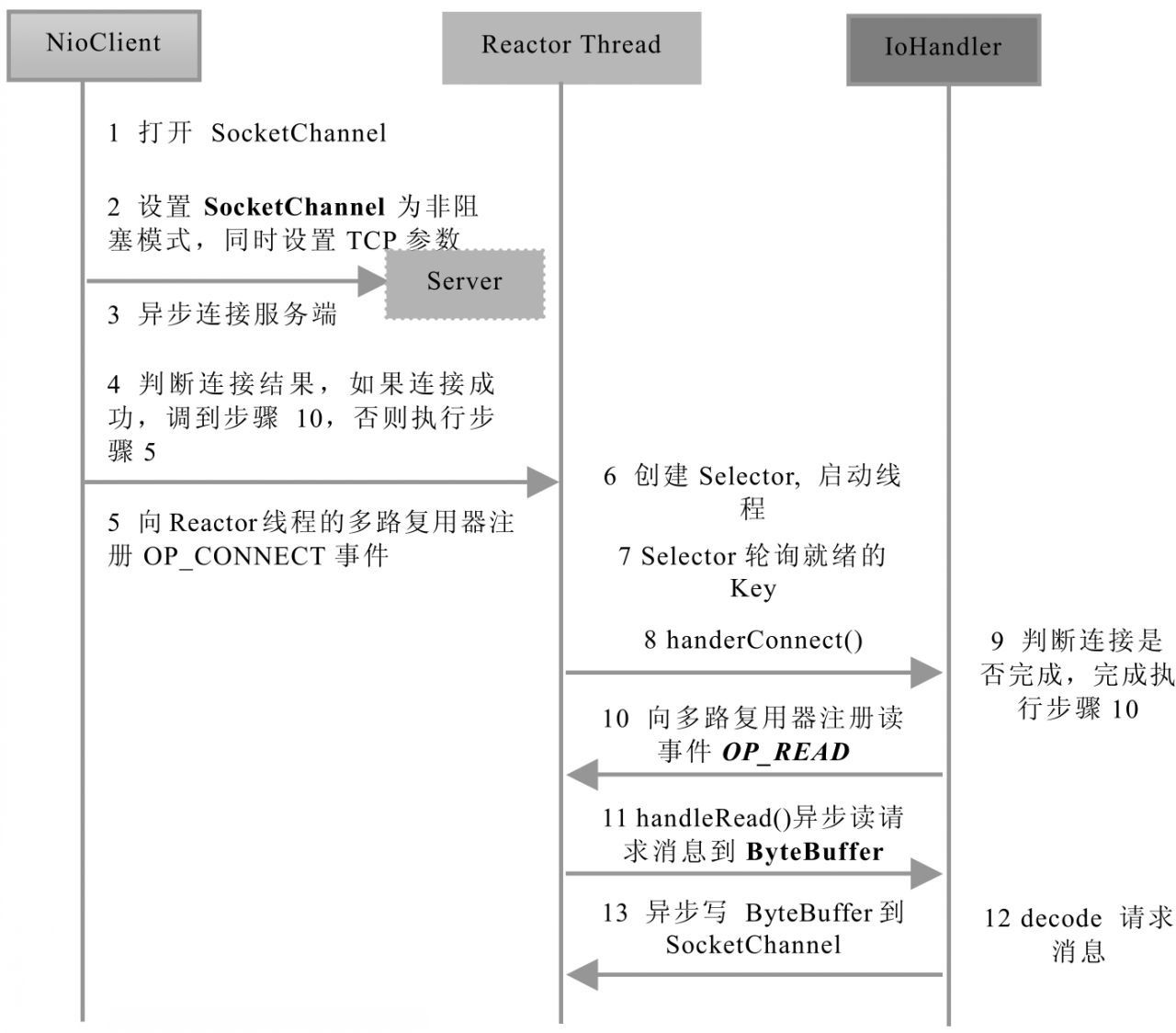一、JAVA NIO
在介绍NIO编程之前,我们首先需要澄清一个概念:NIO到底是什么的简称?有人称之为New I/O,因为它相对于之前的I/O类库是新增的,所以被称为New I/O,这是它的官方叫法。但是,由于之前老的I/O类库是阻塞I/O,New I/O类库的目标就是要让Java支持非阻塞I/O,所以,更多的人喜欢称之为非阻塞I/O(Non-block I/O),由于非阻塞I/O更能够体现NIO的特点,所以本文使用的NIO都指的是非阻塞I/O。
1.1 NIO类库简介
新的输入/输出(NIO)库是在JDK 1.4中引入的。NIO弥补了原来同步阻塞I/O的不足,它在标准Java代码中提供了高速的、面向块的I/O。通过定义包含数据的类,以及通过以块的形式处理这些数据,NIO不用使用本机代码就可以利用低级优化,这是原来的I/O包所无法做到的。下面我们对NIO的一些概念和功能做下简单介绍,以便大家能够快速地了解NIO类库和相关概念。
1.1.1 缓冲区Buffer
我们首先介绍缓冲区(Buffer)的概念,Buffer是一个对象,它包含一些要写入或者要读出的数据。在NIO类库中加入Buffer对象,体现了新库与原I/O的一个重要区别。在面向流的I/O中,可以将数据直接写入或者将数据直接读到Stream对象中。
在NIO库中,所有数据都是用缓冲区处理的。在读取数据时,它是直接读到缓冲区中的;在写入数据时,写入到缓冲区中。任何时候访问NIO中的数据,都是通过缓冲区进行操作。
缓冲区实质上是一个数组。通常它是一个字节数组(ByteBuffer),也可以使用其他种类的数组。但是一个缓冲区不仅仅是一个数组,缓冲区提供了对数据的结构化访问以及维护读写位置(limit)等信息。
最常用的缓冲区是ByteBuffer,一个ByteBuffer提供了一组功能用于操作byte数组。除了ByteBuffer,还有其他的一些缓冲区,事实上,每一种Java基本类型(除了Boolean类型)都对应有一种缓冲区,具体如下:
- ByteBuffer:字节缓冲区
- CharBuffer:字符缓冲区
- ShortBuffer:短整型缓冲区
- IntBuffer:整形缓冲区
- LongBuffer:长整形缓冲区
- FloatBuffer:浮点型缓冲区
- DoubleBuffer:双精度浮点型缓冲区
缓冲区的类图继承关系图:

每一个Buffer类都是Buffer接口的一个子实例。除了ByteBuffer,每一个 Buffer类都有完全一样的操作,只是它们所处理的数据类型不一样。因为大多数标准I/O操作都使用ByteBuffer,所以它除了具有一般缓冲区的操作之外还提供一些特有的操作,方便网络读写。
1.1.2.通道Channel
Channel是一个通道,可以通过它读取和写入数据,它就像自来水管一样,网络数据通过Channel读取和写入。通道与流的不同之处在于通道是双向的,流只是在一个方向上移动(一个流必须是InputStream或者OutputStream的子类),而且通道可以用于读、写或者同时用于读写。
因为Channel是全双工的,所以它可以比流更好地映射底层操作系统的API。特别是在UNIX网络编程模型中,底层操作系统的通道都是全双工的,同时支持读写操作。
Channel的类图继承关系如图:

自顶向下看,前三层主要是Channel接口,用于定义它的功能,后面是一些具体的功能类(抽象类),从类图可以看出,实际上Channel可以分为两大类:分别是用于网络读写的SelectableChannel和用于文件操作的FileChannel。
本文涉及的ServerSocketChannel和SocketChannel都是SelectableChannel的子类,关于它们的具体用法将在后续的代码中体现。
1.1.3.多路复用器Selector
Selector是Java NIO编程的基础,熟练地掌握Selector对于掌握NIO编程至关重要。多路复用器提供选择已经就绪的任务的能力。简单来讲,Selector会不断地轮询注册在其上的Channel,如果某个Channel上面有新的TCP连接接入、读和写事件,这个Channel就处于就绪状态,会被Selector轮询出来,然后通过SelectionKey可以获取就绪Channel的集合,进行后续的I/O操作。
一个多路复用器Selector可以同时轮询多个Channel,由于JDK使用了epoll()代替传统的select实现,所以它并没有最大连接句柄1024/2048的限制。这也就意味着只需要一个线程负责Selector的轮询,就可以接入成千上万的客户端,这确实是个非常巨大的进步。
NIO服务端序列图:

NIO客户端时序图:

1.1.4 NIO代码示例
服务端代码
MultiplexerTimeServer
![]()
package NIO;
import java.io.IOException;
import java.net.InetSocketAddress;
import java.nio.ByteBuffer;
import java.nio.channels.SelectionKey;
import java.nio.channels.Selector;
import java.nio.channels.ServerSocketChannel;
import java.nio.channels.SocketChannel;
import java.util.Date;
import java.util.Iterator;
import java.util.Set;
/**
* Created by user-hfc on 2017/10/29.
*/
public class MultiplexerTimeServer implements Runnable {
private Selector selector;
private ServerSocketChannel servChannel;
private volatile boolean stop;
/**
* 初始化多路复用器,绑定监听端口
*/
public MultiplexerTimeServer(int port) {
try {
selector = Selector.open(); //创建Selector
servChannel = ServerSocketChannel.open(); //打开ServerSocketChannel
servChannel.configureBlocking(false);
servChannel.socket().bind(new InetSocketAddress(port), 1024); //绑定监听地址
servChannel.register(selector, SelectionKey.OP_ACCEPT); //将打开ServerSocketChannel注册到 Selector
System.out.println("The time server is start in port : " + port);
} catch (Exception e) {
e.printStackTrace();
System.exit(1);
}
}
public void stop() {
this.stop = true;
}
@Override
public void run() {
while (!stop) {
try {
selector.select(1000); //selector 轮训就绪的key
Set<SelectionKey> selectionKeys = selector.selectedKeys();
Iterator<SelectionKey> it = selectionKeys.iterator();
SelectionKey key = null;
while (it.hasNext()) {
key = it.next();
it.remove();
try {
handleInput(key); //处理输入
} catch (Exception e) {
if (null != key) {
key.cancel();
if (null != key.channel()) {
key.channel().close();
}
}
}
}
} catch (Exception e2) {
e2.printStackTrace();
}
}
//多路复用器关闭后,所有注册在上面的Channel和pipe等资源都会被自动去注册并关闭
// 所以不需要重复释放资源
if (null != selector) {
try {
selector.close();
} catch (Exception e3) {
e3.printStackTrace();
}
}
}
private void handleInput(SelectionKey key) throws IOException {
//处理新接入的请求信息
if (key.isAcceptable()) {
//Accept the new connection
ServerSocketChannel ssc = (ServerSocketChannel) key.channel();
SocketChannel sc = ssc.accept(); //接受请求
sc.configureBlocking(false);
//Add the new connection to the selector
sc.register(selector, SelectionKey.OP_READ); //接受请求之后注册监听读取请求
}
if (key.isReadable()) {
//Read the data
SocketChannel sc = (SocketChannel) key.channel();
//KB
ByteBuffer readBuffer = ByteBuffer.allocate(1024);
/**
* 由于我们已经将SocketChannel设置为异步非阻塞模式,因此这里的read()是非阻塞的
* 使用返回值进行判断,有三种可能的结果
* 返回值大于0:读取到字节,对字节进行编解码
* 返回值等于0:没有读取到字节,属于正常场景,忽略
* 返回值等于-1:链路已经关闭,需要关闭SocketChannel,释放资源
*/
int readBytes = sc.read(readBuffer);
if (readBytes > 0) {
//把buffer的当前位置更改成buffer缓冲区的第一个位置
//用于后续对缓冲区的读取操作
readBuffer.flip();
byte[] bytes = new byte[readBuffer.remaining()];
readBuffer.get(bytes);
String body = new String(bytes, "utf-8");
System.out.println("The time server receive order : " + body);
String currentTime = "QUERY TIME ORDER".equalsIgnoreCase(body)
? new Date(System.currentTimeMillis()).toString() : "BAD ORDER";
doWrite(sc, currentTime);
} else if (readBytes < 0) {
//对端链路关闭
key.cancel();
sc.close();
} else {
//读到0字节,忽略
}
}
}
private void doWrite(SocketChannel channel, String response) throws IOException {
if (null != response && response.trim().length() > 0) {
byte[] bytes = response.getBytes();
ByteBuffer writeBuffer = ByteBuffer.allocate(bytes.length);
writeBuffer.put(bytes);
writeBuffer.flip();
channel.write(writeBuffer);
}
}
}
![]()
TimeServer
![]()
package NIOInduction.NIO.Server;
import java.io.IOException;
/**
* Created by IntelliJ IDEA 14.
* User: karl.zhao
* Time: 2015/11/25 0025.
*/
public class TimeServer {
public static void main(String[] args) throws IOException {
int port = 8080;
if (args != null && args.length > 0) {
try {
port = Integer.valueOf(args[0]);
} catch (NumberFormatException ex) {
}
}
MultiplexerTimeServer timeServer = new MultiplexerTimeServer(port);
new Thread(timeServer, "NIO-MultiplexerTimeServer-001").start();
}
}
![]()
客户端代码
TimeClientHandle
![]()
package NIOInduction.NIO.Client;
import java.io.IOException;
import java.net.InetSocketAddress;
import java.nio.ByteBuffer;
import java.nio.channels.SelectionKey;
import java.nio.channels.Selector;
import java.nio.channels.SocketChannel;
import java.util.Iterator;
import java.util.Set;
/**
* Created by IntelliJ IDEA 14.
* User: karl.zhao
* Time: 2015/11/25 0025.
*/
public class TimeClientHandle implements Runnable {
private String host;
private int port;
private Selector selector;
private SocketChannel socketChannel;
private volatile boolean stop;
public TimeClientHandle(String host, int port) {
this.host = host == null ? "127.0.0.1" : host;
this.port = port;
try {
selector = Selector.open();
socketChannel = SocketChannel.open();
socketChannel.configureBlocking(false);
} catch (IOException e) {
e.printStackTrace();
System.exit(1);
}
}
public void run() {
try {
doConnect();
} catch (IOException e) {
e.printStackTrace();
System.exit(1);
}
while (!stop) {
try {
selector.select(1000);
Set<SelectionKey> selectionKeys = selector.selectedKeys();
Iterator<SelectionKey> it = selectionKeys.iterator();
SelectionKey key = null;
while (it.hasNext()) {
key = it.next();
it.remove();
try {
handleInput(key);
} catch (Exception e) {
if (key != null) {
key.cancel();
if (key.channel() != null) key.channel().close();
}
}
}
} catch (Exception e) {
e.printStackTrace();
System.exit(1);
}
}
// 多路复用器关闭后,所有注册在上面的Channel和Pipe等资源都会被自动注册并关闭,所以不需要重新释放资源
if (selector != null) {
try {
selector.close();
} catch (IOException e) {
e.printStackTrace();
}
}
}
private void handleInput(SelectionKey key) throws IOException {
if (key.isValid()) {
// 判断是否连接成功
SocketChannel sc = (SocketChannel) key.channel();
if (key.isConnectable()) {
if (sc.finishConnect()) {
// Add the new connection to the selector
sc.register(selector, SelectionKey.OP_READ);
doWrite(sc);
} else System.exit(1); // 连接失败,退出进程
}
if (key.isReadable()) {
// read data
ByteBuffer readBuffer = ByteBuffer.allocate(1024);
int readBytes = sc.read(readBuffer);
if (readBytes > 0) {
readBuffer.flip();
byte[] bytes = new byte[readBuffer.remaining()];
readBuffer.get(bytes);
String body = new String(bytes, "UTF-8");
System.out.println("Now is : " + body);
this.stop = true;
} else if (readBytes < 0) {
// 对端链路关闭
key.cancel();
sc.close();
} else ; // 读到0字节,忽略
}
}
}
private void doConnect() throws IOException {
// 如果连接成功,则注册到多路复用器上,发送请求,读应答
if (socketChannel.connect(new InetSocketAddress(host, port))) {
socketChannel.register(selector, SelectionKey.OP_READ);
doWrite(socketChannel);
} else {
socketChannel.register(selector, SelectionKey.OP_CONNECT);
}
}
private void doWrite(SocketChannel sc) throws IOException {
byte[] req = "QUERY TIME ORDER".getBytes();
ByteBuffer writeBuffer = ByteBuffer.allocate(req.length);
writeBuffer.put(req);
writeBuffer.flip();
sc.write(writeBuffer);
if (!writeBuffer.hasRemaining()) System.out.println("Send order 2 service succeed");
}
}
![]()
TimeClient
![]()
package NIOInduction.NIO.Client;
/**
* Created by IntelliJ IDEA 14.
* User: karl.zhao
* Time: 2015/11/25 0025.
*/
public class TimeClient {
public static void main(String[] agrs) {
int port = 8080;
String hostAddr = "127.0.0.1";
if (agrs != null && agrs.length == 1) {
try {
port = Integer.valueOf(agrs[0]);
} catch (NumberFormatException ex) {
}
} else if (agrs != null && agrs.length == 2) {
try {
hostAddr = agrs[0];
port = Integer.valueOf(agrs[1]);
} catch (NumberFormatException ex) {
}
}
for (int i = 1; i <= 1000; i++) {
TimeClientHandle tc = new TimeClientHandle(hostAddr, port);
Thread tt = new Thread(tc, "线程" + i);
try {
// tt.sleep(1000);
tt.start();
} catch (Exception e) {
}
}
}
}
![]()
二、JAVA AIO
NIO2.0引入了新的异步通道的概念,并提供了异步文件通道和异步套接字通道的实现。异步通道提供两种方式获取获取操作结果。
- 通过java.util.concurrent.Future类来表示异步操作的结果;
- 在执行异步操作的时候传入一个java.nio.channels。
CompletionHandler接口的实现类作为操作完成的回调。
NIO2.0的异步套接字通道是真正的异步非阻塞I/O,它对应UNIX网络编程中的事件驱动I/O(AIO),它不需要通过多路复用器(Selector)对注册的通道进行轮询操作即可实现异步读写,从而简化了NIO的编程模型。
下面通过代码来熟悉NIO2.0 AIO的相关类库,仍旧以时间服务器为例程进行讲解。
服务端代码
ReadCompletionHandler
![]()
package NIOInduction.AIO.Server;
import java.io.IOException;
import java.io.UnsupportedEncodingException;
import java.nio.ByteBuffer;
import java.nio.channels.AsynchronousSocketChannel;
import java.nio.channels.CompletionHandler;
import java.util.Date;
/**
* Created by IntelliJ IDEA 14.
* User: karl.zhao
* Time: 2015/11/26 0026.
*/
public class ReadCompletionHandler implements CompletionHandler<Integer, ByteBuffer> {
private AsynchronousSocketChannel channel;
public ReadCompletionHandler(AsynchronousSocketChannel channel) {
this.channel = channel;
}
@Override
public void completed(Integer result, ByteBuffer attachment) {
attachment.flip();
byte[] body = new byte[attachment.remaining()];
attachment.get(body);
try {
String req = new String(body, "UTF-8");
System.out.println("the time server seceive order : " + req);
String currentTime = "QUERY TIME ORDER".equalsIgnoreCase(req) ? new Date(
System.currentTimeMillis()
).toString() : "BAD ORDER";
doWrite(currentTime);
} catch (UnsupportedEncodingException e) {
e.printStackTrace();
}
}
private void doWrite(String currentTime) {
if (currentTime != null && currentTime.trim().length() > 0) {
byte[] bytes = (currentTime).getBytes();
ByteBuffer writeBuffer = ByteBuffer.allocate(bytes.length);
writeBuffer.put(bytes);
writeBuffer.flip();
channel.write(writeBuffer, writeBuffer,
new CompletionHandler<Integer, ByteBuffer>() {
public void completed(Integer result, ByteBuffer attachment) {
// 如果没有发送完成,则继续发送
if (attachment.hasRemaining())
channel.write(attachment, attachment, this);
}
public void failed(Throwable exc, ByteBuffer attachment) {
try {
channel.close();
} catch (IOException e) {
}
}
});
}
}
@Override
public void failed(Throwable exc, ByteBuffer attachment) {
try {
this.channel.close();
} catch (IOException e) {
e.printStackTrace();
}
}
}
![]()
AcceptCompletionHandler
![]()
package NIOInduction.AIO.Server;
import java.nio.ByteBuffer;
import java.nio.channels.AsynchronousSocketChannel;
import java.nio.channels.CompletionHandler;
/**
* Created by IntelliJ IDEA 14.
* User: karl.zhao
* Time: 2015/11/26 0026.
*/
public class AcceptCompletionHandler implements CompletionHandler<AsynchronousSocketChannel, AsyneTimeServerHandler> {
@Override
public void completed(AsynchronousSocketChannel result, AsyneTimeServerHandler attachment) {
attachment.asynchronousServerSocketChannel.accept(attachment, this);
ByteBuffer buffer = ByteBuffer.allocate(1024);
result.read(buffer, buffer, new ReadCompletionHandler(result));
}
@Override
public void failed(Throwable exc, AsyneTimeServerHandler attachment) {
exc.printStackTrace();
attachment.latch.countDown();
}
}
![]()
AsyneTimeServerHandler
![]()
package NIOInduction.AIO.Server;
import java.io.IOException;
import java.net.InetSocketAddress;
import java.nio.channels.AsynchronousServerSocketChannel;
import java.util.concurrent.CountDownLatch;
/**
* Created by IntelliJ IDEA 14.
* User: karl.zhao
* Time: 2015/11/26 0026.
*/
public class AsyneTimeServerHandler implements Runnable {
private int port;
CountDownLatch latch;/* 一个同步辅助类,在完成一组正在其他线程中执行的操作之前,它允许一个或多个线程一直等待。*/
AsynchronousServerSocketChannel asynchronousServerSocketChannel;
public AsyneTimeServerHandler(int port) {
this.port = port;
try {
asynchronousServerSocketChannel = AsynchronousServerSocketChannel.open();
asynchronousServerSocketChannel.bind(new InetSocketAddress(port));
System.out.println("The Server start in port : " + port);
} catch (IOException e) {
e.printStackTrace();
}
}
public void run() {
latch = new CountDownLatch(1);
doAccept();
try {
latch.await();
} catch (InterruptedException e) {
e.printStackTrace();
}
}
public void doAccept() {
asynchronousServerSocketChannel.accept(this, new AcceptCompletionHandler());
}
}
![]()
TimeServer
![]()
package NIOInduction.AIO.Server;
import java.io.IOException;
/**
* Created by IntelliJ IDEA 14.
* User: karl.zhao
* Time: 2015/11/26 0026.
*/
public class TimeServer {
public static void main(String[] args) throws IOException {
int port = 8080;
if (args != null && args.length > 0) {
try {
port = Integer.valueOf(args[0]);
} catch (NumberFormatException ex) {
}
}
AsyneTimeServerHandler timeServer = new AsyneTimeServerHandler(port);
new Thread(timeServer, "xxxx").start();
}
}
![]()
客户端代码
AsyncTimeClientHandler
![]()
package NIOInduction.AIO.Client;
import java.io.IOException;
import java.io.UnsupportedEncodingException;
import java.net.InetSocketAddress;
import java.nio.ByteBuffer;
import java.nio.channels.AsynchronousSocketChannel;
import java.nio.channels.CompletionHandler;
import java.util.concurrent.CountDownLatch;
/**
* Created by IntelliJ IDEA 14.
* User: karl.zhao
* Time: 2015/11/26 0026.
*/
public class AsyncTimeClientHandler implements
CompletionHandler<Void, AsyncTimeClientHandler>, Runnable {
private AsynchronousSocketChannel client;
private String host;
private int port;
private CountDownLatch latch;
public AsyncTimeClientHandler(String host, int port) {
this.host = host;
this.port = port;
try {
client = AsynchronousSocketChannel.open();
} catch (IOException e) {
e.printStackTrace();
}
}
@Override
public void run() {
latch = new CountDownLatch(1);
client.connect(new InetSocketAddress(host, port), this, this);
try {
latch.await();
} catch (InterruptedException e1) {
e1.printStackTrace();
}
try {
client.close();
} catch (IOException e) {
e.printStackTrace();
}
}
@Override
public void completed(Void result, AsyncTimeClientHandler attachment) {
byte[] req = "QUERY TIME ORDER".getBytes();
ByteBuffer writeBuffer = ByteBuffer.allocate(req.length);
writeBuffer.put(req);
writeBuffer.flip();
client.write(writeBuffer, writeBuffer,
new CompletionHandler<Integer, ByteBuffer>() {
@Override
public void completed(Integer result, ByteBuffer buffer) {
if (buffer.hasRemaining()) {
client.write(buffer, buffer, this);
} else {
ByteBuffer readBuffer = ByteBuffer.allocate(1024);
client.read(
readBuffer,
readBuffer,
new CompletionHandler<Integer, ByteBuffer>() {
@Override
public void completed(Integer result,
ByteBuffer buffer) {
buffer.flip();
byte[] bytes = new byte[buffer
.remaining()];
buffer.get(bytes);
String body;
try {
body = new String(bytes,
"UTF-8");
System.out.println("Now is : "
+ body);
latch.countDown();
} catch (UnsupportedEncodingException e) {
e.printStackTrace();
}
}
@Override
public void failed(Throwable exc,
ByteBuffer attachment) {
try {
client.close();
latch.countDown();
} catch (IOException e) {
// ingnore on close
}
}
});
}
}
@Override
public void failed(Throwable exc, ByteBuffer attachment) {
try {
client.close();
latch.countDown();
} catch (IOException e) {
// ingnore on close
}
}
});
}
@Override
public void failed(Throwable exc, AsyncTimeClientHandler attachment) {
exc.printStackTrace();
try {
client.close();
latch.countDown();
} catch (IOException e) {
e.printStackTrace();
}
}
}
![]()
TimeClient
![]()
package NIOInduction.AIO.Client;
/**
* Created by IntelliJ IDEA 14.
* User: karl.zhao
* Time: 2015/11/26 0026.
*/
public class TimeClient {
public static void main(String[] args) {
int port = 8080;
if (args != null && args.length > 0) {
try {
port = Integer.valueOf(args[0]);
} catch (NumberFormatException e) {
// 采用默认值
}
}
for (int i = 1; i <= 20; i++) {
AsyncTimeClientHandler tc = new AsyncTimeClientHandler("127.0.0.1", port);
Thread tt = new Thread(tc, "线程" + i);
try {
// tt.sleep(1000);
tt.start();
} catch (Exception e) {
}
}
}
}
![]()
三、4种I/O对比
3.1 概念澄清
1.异步非阻塞IO
很多人喜欢将JDK1.4提供的NIO框架称为异步非阻塞I/O,但是,如果严格按照UNIX网络编程模型和JDK的实现进行区分,实际上它只能被称为非阻塞I/O,不能叫异步非阻塞I/O。在早期的JDK1.4和1.5 update10版本之前,JDK的Selector基于select/poll模型实现,它是基于I/O复用技术的非阻塞I/O,不是异步I/O。在JDK1.5 update10和Linux core2.6以上版本,Sun优化了Selctor的实现,它在底层使用epoll替换了select/poll,上层的API并没有变化,可以认为是JDK NIO的一次性能优化,但是它仍旧没有改变I/O的模型。
由JDK1.7提供的NIO2.0,新增了异步的套接字通道,它是真正的异步I/O,在异步I/O操作的时候可以传递信号变量,当操作完成之后会回调相关的方法,异步I/O也被称为AIO。
2.多路复用器Selector
在前面的章节我们介绍过Java NIO的实现关键是多路复用I/O技术,多路复用的核心就是通过Selector来轮询注册在其上的Channel,当发现某个或者多个Channel处于就绪状态后,从阻塞状态返回就绪的Channel的选择键集合,进行I/O操作。由于多路复用器是NIO实现非阻塞I/O的关键,它又是主要通过Selector实现的,所以本文将Selector翻译为多路复用器,与其他技术书籍所说的选择器是同一个东西。
3.伪异步IO
伪异步I/O的概念完全来源于实践。在JDK NIO编程没有流行之前,为了解决Tomcat通信线程同步I/O导致业务线程被挂住的问题,大家想到了一个办法:在通信线程和业务线程之间做个缓冲区,这个缓冲区用于隔离I/O线程和业务线程间的直接访问,这样业务线程就不会被I/O线程阻塞。而对于后端的业务侧来说,将消息或者Task放到线程池后就返回了,它不再直接访问I/O线程或者进行I/O读写,这样也就不会被同步阻塞。类似的设计还包括前端启动一组线程,将接收的客户端封装成Task,放到后端的线程池执行,用于解决一连接一线程问题。像这样通过线程池做缓冲区的做法,本书中习惯于称它为伪异步I/O,而官方并没有伪异步I/O这种说法,请大家注意。
3.2 不同IO模型对比
























 1756
1756

 被折叠的 条评论
为什么被折叠?
被折叠的 条评论
为什么被折叠?








